Continue shopping
and explore our products below:
Finding Stillness in a Busy World: How to Reconnect with Your Inner Harmony

In today’s world, stillness has become rare. We live surrounded by screens, alerts, and endless to-do lists. Our attention is constantly pulled in every direction. Yet deep within us, there’s a quiet space that never changes — a calm presence waiting to be heard. To rediscover that calm, explore how understanding your inner harmony can help you realign with balance and clarity.
That space is your inner harmony. Finding it doesn’t require escaping your life. It begins by slowing down, breathing, and remembering that peace is already within you — a concept deeply connected to the practice of finding stillness in a busy world.
1. The Noise Around Us
It’s easy to confuse being busy with being productive. We rush from one task to another, convinced that momentum equals progress. But the faster we move, the more disconnected we become — from our thoughts, our bodies, and our emotions. Practicing simple journaling habits can help slow your pace and bring awareness back into your day.
The constant flow of information makes silence uncomfortable. We open our phones the moment we pause. Yet stillness isn’t about doing nothing. It’s about doing one thing with full presence. It’s choosing awareness over autopilot.
When you sit quietly — even for a few minutes — your nervous system begins to relax. Your thoughts slow down. You remember that you’re not just reacting to life; you’re living it.
2. Why Stillness Matters
Stillness is not a luxury. It’s a necessity for a healthy mind and body.
Without it, our stress hormones stay high, our creativity fades, and our emotions stay tangled. When we create moments of quiet, we restore balance and give our minds room to breathe.
Stillness isn’t the absence of movement — it’s the presence of awareness
Even a few minutes of stillness a day can:
- Reduce stress and mental fatigue
- Improve emotional regulation
- Boost focus and clarity
- Deepen your sense of connection with yourself
Stillness is what allows gratitude to surface, creativity to flow, and healing to begin. You can amplify this awareness through daily gratitude journaling.
3. The Mind–Body Connection
Your body feels what your mind believes.
When you’re anxious, your shoulders tighten, your breathing becomes shallow, and your body prepares for defense. But when you intentionally breathe deeply, stretch gently, or sit in silence, you send a signal of safety to your entire system.
This shift in your body’s state helps calm your mind.
Mindfulness isn’t just mental — it’s physical. Each breath can be a bridge between tension and tranquility.
Try this simple practice right now:
Breathe in for four seconds. Hold for two. Exhale for six.
Notice the difference — not in your thoughts, but in how your body softens.
4. How to Practice Stillness Daily
You don’t need hours of meditation or a perfect environment to find stillness. You need small, conscious pauses that anchor you to the present moment. Here’s how to begin:
Morning silence
Before you look at your phone, sit quietly for one minute.
Notice your breath. Feel your body waking up. Begin the day from awareness instead of rush.
Single-tasking
Do one thing at a time — fully. When you eat, taste your food. When you walk, feel each step. This practice turns routine moments into meditative ones.
Digital boundaries
Set limits on notifications. Create screen-free zones — even 30 minutes a day helps. Protect your attention like something sacred, because it is.
Nature connection
Go outside or sit by a window. Listen to the wind, watch the light shift. Nature restores calm without asking for anything in return.
Evening reflection
End your day with gratitude or a short journal entry. Write one peaceful thought or something that went well. It’s a simple way to close the day in harmony.
5. Let Go of the “Perfect” Routine
Stillness isn’t another goal to master. You can’t fail at mindfulness. As shared in The Power of Daily Habits, growth comes from consistency, not perfection.
Some days your mind will wander, and that’s okay. Awareness grows through gentle repetition, not perfection.
If you notice yourself distracted during a moment of stillness, smile at that realization. That awareness is mindfulness. Every time you return to the present, you strengthen your inner calm.
The key is consistency — not control.
6. Reconnecting with Yourself
In silence, you hear the quiet truth of your heart.
You begin to sense what feels right, what feels forced, and what needs to change. That inner voice has always been there; stillness simply helps you listen.
Finding stillness in a busy world isn’t about escaping noise — it’s about learning to hear your own calm beneath it.
When you reconnect with yourself, decisions become clearer, emotions soften, and you stop seeking validation from outside sources.
Inner harmony comes from trusting that you already have what you need.
7. Journaling for Inner Harmony

Writing helps transform awareness into insight. The act of putting thoughts on paper clears emotional clutter and strengthens mindfulness — a practice expanded on in 10 Journaling Habits That Will Transform Your Life.
If you’re using the iAmEvolving Journal, here are a few prompts to explore:
- What helps me feel grounded and calm?
- Which parts of my day feel rushed — and why?
- What can I let go of to feel more at peace?
- When was the last time I felt fully present?
- What does inner harmony mean to me today?
Your answers will change with time — and that’s the beauty of growth.
Not sure where to begin? Start with the iAmEvolving™ Guidebook to learn the method, then get the Journal when you're ready.
8. Living with Harmony
Inner harmony isn’t found in perfect conditions; it’s built through presence.
It’s when you wash dishes with awareness, take a mindful walk, or pause to breathe before replying in frustration.
It’s knowing you can return to yourself — anytime, anywhere.
Stillness teaches you that peace isn’t something to chase.
It’s something you allow.
As you make space for quiet moments, you’ll notice more than calm — you’ll rediscover joy, gratitude, and the simple beauty of being.
Stillness isn’t something you find; it’s something you remember — a space that’s always been within you. Each quiet pause reconnects you to that awareness. To explore how stillness fits within the greater path of emotional balance, return to The Inner Harmony Guide — your companion for understanding, mapping, and living in alignment with your inner calm.


